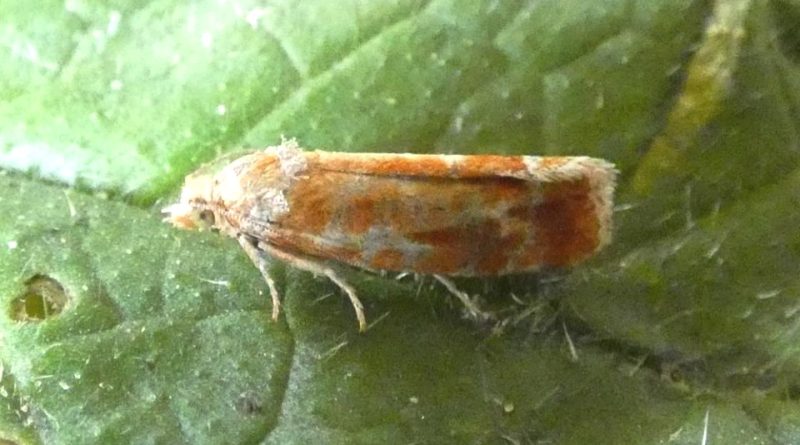Rhyacionia buoliana
Rhyacionia buoliana
The European pine shoot moth or pine shoot moth (Rhyacionia buoliana Denis & Schiffermüller, 1775) is a moth belonging to the Tortricidae family.
Systematics –
From a systematic point of view it belongs to:
Eukaryota domain,
Kingdom Animalia,
Subkingdom Eumetazoa,
Superphylum Protostomia,
Phylum Arthropoda,
Subphylum Tracheata,
Superclass Hexapoda,
Class Insecta,
Subclass Pterygota,
Endopterygota cohort,
Superorder Oligoneoptera,
panorpoid section,
Order Lepidoptera,
Glossata suborder,
Infraorder Heteroneura,
Ditrysia division,
Superfamily Tortricoidea,
Family Tortricidae,
Subfamily Tortricinae,
Tortricini tribe,
Genus Rhyacionia,
Species R. buoliana.
The term is basionym:
– Tortrix buoliana (Denis & Schiffermüller) 1775.
The terms are synonyms:
– Evetria buoliana (Denis & Schiffermüller, 1775);
– Phalaena gemmatella Panzer, 1804;
– Phalaena herbstella Goeze, 1783;
– Retinia buoliana (Denis & Schiffermüller, 1775);
– Rhyacionia milleri Agenjo, 1963
– Rhyacionia relictana Le Cerf, 1932;
– Rhyacionia riesgoi Agenjo, 1963;
– Rhyacionia robredoi Agenjo, 1963;
– Tortrix gemmana Hübner;
– Tortrix pallasana Sodoffsky, 1830.
All’interno di questa specie vengono riconosciute le seguenti sottospecie:
– Rhyacionia buoliana subsp. buoliana;
– Rhyacionia buoliana subsp. thurificana (Lederer, 1855).
Geographic Distribution and Habitat –
Rhyacionia buoliana is a moth native to North Africa, northern Asia and Europe while it is invasive in North America and South America.
The larvae of this small moth feed on pine. The original host plants are Pinus sylvestris and Pinus nigra. However, when the insect arrived in North and South America, the spectrum of host plants expanded to include more members of the genus Pinus; furthermore this is also reported on Abies alba.
Morphology –
Rhyacionia buoliana is a small moth which, in the adult stage, has a wingspan of 16-24 mm. The fore wings are ferruginous-orange in colour, often partly suffused with dark red and with numerous silvery-white transversal irregular streaks and bands.
The hind wings are light gray.
The larvae have a length of about 20-22 mm when ripe, are ocher in colour, more or less intense, with reddish hues; the head and the first dorsal parts of the thorax are blackish.
Attitude and biological cycle –
Rhyacionia buoliana overwinters in the third age larva stage, inside the affected shoots during the summer.
By the end of winter-beginning of spring, this larva becomes active again, feeding on the shoot in which it wintered and/or also damaging some nearby shoots which typically dry up.
When the larvae reach maturity, they pupate inside the shoots; the adults flicker in the late spring period, normally between the end of May and the whole month of June, with the possibility, under certain climatic conditions, of arriving up to the month of July and can be seen in flight up to the month of August in western Europe .
The mating of the adults takes place immediately after and the females lay lenticular, yellow-ochreous eggs, singly or in groups, on the leaves of the pines.
The young larvae born during the summer months begin to feed on the needles at first, after which they move to the buds and shoots, being able to cause considerable damage.
The larvae that reach the third age are those that overwinter.
In this degree this insect completes one generation per year.
Ecological Role –
In the event of a massive presence of this moth, considerable damage can be caused to pine plants (in particular Pinus sylvestris and Pinus nigra).
The damage is caused by the larvae which undermine the buds and shoots, in which they dig tunnels in the central part.
The consequences of the attack can be serious, especially on young plants, still in formation; in this case the attack causes a blinding of the buds which do not open, or else they give rise to a weak bud which necrotizes and dries up almost immediately. With the blinding of the buds, the plant reacts by awakening the lateral shoots with “flat” growth of the crown or with splitting of the stem; in any case there is an abnormal development of the plant which takes on forms other than the normal conical habit.
Furthermore, the undermined shoots may not dry out but react with deformations, elbow or lateral curvatures. In these cases the branches can resume normal apical growth, however with lignification, curvature or deformation will remain, as an evident sign of the attack suffered.
The intervention against Rhyacionia buoliana must always be carried out behind careful monitoring and evaluation of collateral damage.
The technique involves the use of pheromone sex traps for population monitoring. If necessary, the treatment must be carried out at the moment of maximum oviposition, which corresponds approximately to the second-third ten days of June; however the treatments are mainly carried out in the nursery.
Until now, the fight against this moth has been chemical, following the criteria of guided and integrated fight. Sex traps should be installed in the second half of May.
However, the success of the struggle is largely determined by the timeliness of the intervention; in fact, when the larvae enter the shoots it is almost no longer possible to reach them with insecticides.
In products used have been based on phosalone or azinphos-methyl.
However, please note that this small moth also has natural parasites, which should therefore be monitored in advance. Among these we mention the tachinid fly Actia nudibasis.
Guido Bissanti
Sources
– Wikipedia, the free encyclopedia.
– GBIF, the Global Biodiversity Information Facility.
– Russo G., 1976. Agricultural entomology. Special Part. Liguori Publisher, Naples.
– Pollini A., 2002. Handbook of applied entomology. Edagricole, Bologna.
– Tremblay E., 1997. Applied entomology. Liguori Publisher, Naples.
Photo source:
– https://observation.org/photos/62216869.jpg

